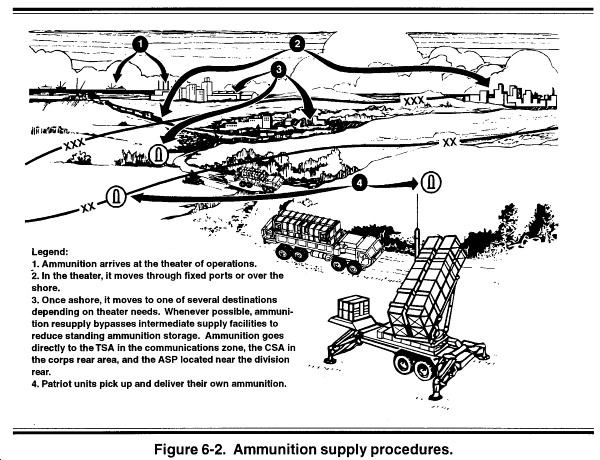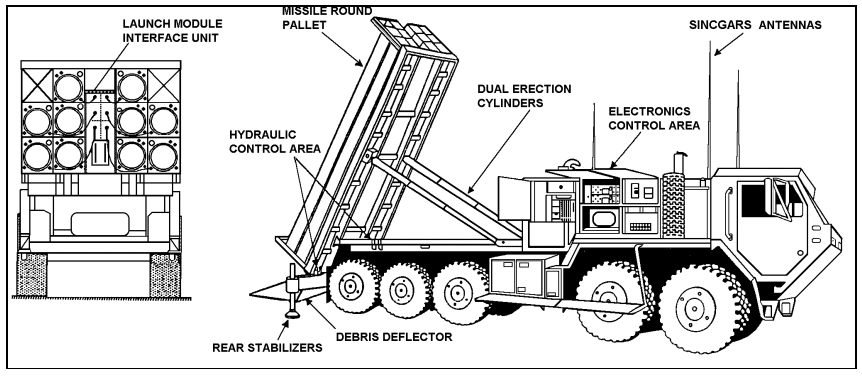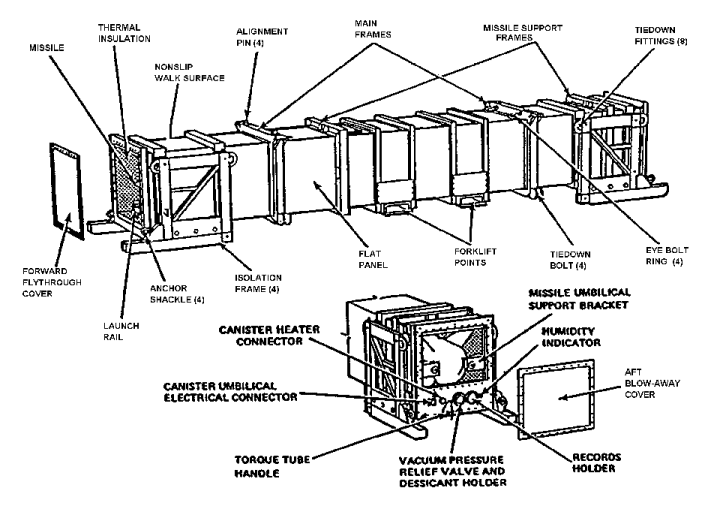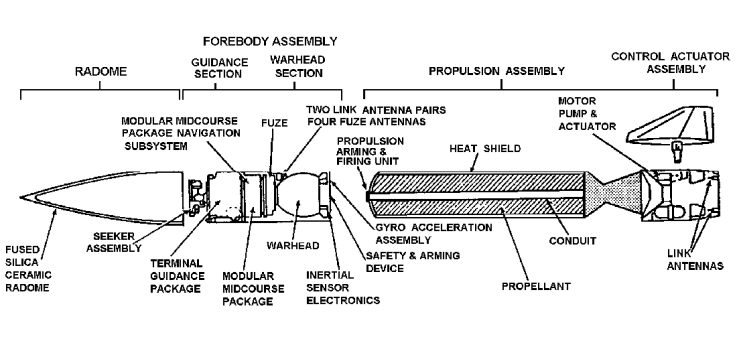MIM-104 Patriot English Version
Version Française
The Patriot missile defence system is designed to detect and destroy incoming enemy tactical ballistic missiles, cruise missiles or aircraft.
It comprises a radar, control centre and associated power supply and communications towers, and launchers on trucks. US Army uses usually five to eight in a battery. Each launcher holds four missiles - or 16 in the latest "Pac-3" version. The launchers can be up to a kilometre away from the radar and control hub, linked by microwave signals. The trailer-mounted radar is a "phased array" type - it scans the sky with a narrow beam which flicks between thousands of locations each second. If it detects something, up to 100 km away, it focuses on it and relays information about it to the control centre. It can track up to 100 targets and send guidance data for up to nine missiles.
.jpg) |
| The Threats ( Internet ) |
Patriots are used by the USA, Germany, Netherlands, Japan, Israel, Saudi Arabia, Kuwait, Taiwan, Greece.
Raytheon Company
.jpg) |
.png) |
.jpg) |
| Laurence K Marshall |
|
Vannevar Bush |
Raytheon Company is a major American military company based in Waltham Massachusetts It is the second largest military contractor in the world.
He was born in 1922 when two former college roommates Laurence K. Marshall and Vannevar Bush, along with scientist Charles G. Smith, founded the American Appliance Company. The company's first product was a gaseous rectifier, called the Raytheon and used for radio-receiver power supplies that plugged into the power grid in place of large batteries. The company changed its name to Raytheon in 1925.During WW2 Raytheon manufactured tubes for use in radar and then complete radar systems.
.jpg) |
.jpg) |
In 1945 Percy Spencer of Raytheon invented the microwave oven (the inmagnetron could also cook food.) and in 1948 Raytheon began to manufacture guided missiles
Now for Raytheon missiles still form a large part of his business
AGM-129 ACM Cruise missile
AGM 65 Maverick
AIM 9 Sidewinder
AGM 88 Harm
Raytheon also manufactures for the electronics industry.. It also makes several software radio and digital communication systems for military applications and for civilian projects in the aircraft industry.
History
The MIM-104 Patriot is the medium/long-range surface-to-air missile in current operational U.S. Army inventory. The Patriot system,is complemented now by the new PAC 3 missile,
.jpg) |
| Internet |
Now The Patriot System replaced the Nike Hercules system as primary High to Medium Air Defense (HIMAD) platform, and replaced the MIM 23 Hawk system as medium tactical air defense platform. But is primary mission was now the role as anti ballistic missile (ABM) platform,
.gif) |
| Internet |
For little story The name "Patriot" is the acronym for Phased Array TRacking to Intercept of Target but also the Patriot is also a soldier as the Minuteman during the War of Independance.
. Studies for an advanced surface-to-air missile to supplement and eventually replace the MIM 23 Hawk already began in 1961 under the FABMDS (Field Army Ballistic Missile Defense System) program.
The name was later changed to AADS-70 (Army Air-Defense System - 1970), and finally in October 15th 1964 to SAM-D (Surface-to-Air Missile - Development). Specifications were vague and changed frequently, but always included
the ability to counter aircraft threats of all types,
The ability to counter threats TBM (Theater Ballistic Missiles, a.k.a. short-range ballistic missiles) capability.
In May 1967, Raytheon was selected as prime contractor for SAM-D development, and firing trials of SAM-D test missiles began in November 1969. The engineering development phase began in 1973, but in January 1974, a major change in the requirements occurred. It was directed that SAM-D should use Track-Via-Missile (TVM) guidance, i.e. target tracking information is not received by the ground radar directly, but by the missile which transmits it to the ground control station.
Tthis method significantly enhances accuracy and the ability to discriminate decoys from the real threat. This new requirement of course significantly delayed the development, and full-scale development didn't start until January 1976, after TVM had been demonstrated in tests in 1975.
In May 1976 the official designation XMIM-104A was assigned, and, SAM-D was named Patriot. Testing of the missile and the Patriot ground equipment continued through the late 1970s, and in October 1980, the first production contract for the MIM-104A Patriot missile was issued. In 1984, the Patriot finally reached Initial Operation Capability with its first U.S. Army units. In 1988 it was upgraded to provide limited capability against Tactical Ballistic Missiles (TBM) as PAC-1 (Patriot Advanced Capability-1). The most recent upgrade, called PAC-3, is a nearly total system redesign, intended from the outset to engage and destroy tactical ballistic missiles.
The AN/MPQ-53 and AN/MPQ-65 Radar Set
.jpg) |
.gif) |
.jpg) |
| Internet |
Internet |
Internet |
The multifunction phased array radar mounted on an M-860 semi-trailer towed by an M983, heavy expanded mobility tactical truck (HEMTT )The AN/MPQ-53 Radar Set equips PAC-2 and older units, and the AN/MPQ-65 Radar Set equips PAC-3 units It is monitored and controlled by the ECS via the radar and weapon control interface unit. It performs very low- to very high-altitude surveillance, target detection, target classification, target identification, target track, missile track, missile guidance, and ECCM functions.
The radar antenna is positioned at the forward end of the shelter and is erected to a fixed 67.5 angle relative to the horizontal plane during emplacement. Integral leveling equipment on the M-860 semi-trailer permits emplacement on slopes of up to 10.. This gives the radar an unmatched ability to detect small, fast targets like ballistic missiles, or low targets such as stealth aircraft or cruise missile.. Then the "radar image" in the missile's seeker can be used, together with the high computing power of the ECS, to discriminate decoys and calculate the interception path. At the interception point, the missile's warhead is detonated by a radar-proximity fuze.
The AN/MSQ-104 Engagement Control Station.
.jpg) |
.gif) |
.jpg) |
| Internet |
Internet |
Internet |
 |
| Internet |
The ECS is the operational control center of the Patriot FUHe contains the WCC, man/machine interface and various data and communications terminals. The ECS is air-conditioned and includes protection devices for use in NBC and EMP environments
.gif) |
| Internet |
The ECS shelter provides shielding from RFI and is a weather-tight enclosure with appropriate air inlet and exhaust ports for the environmental control systems. The left side as seen from the doorway includes three UHF RRT and a voice communications station. The right side includes the very high frequency (VHF) DLT, radar weapon control interface unit (RWCIU), WCC, an AN/VRC-92A SINCGARS radio, optical disc drives (ODD) and embedded data recorder
Parts of the ECS are
Weapons Control Computer (WCC),
The WCC is the main computer within the Patriot system.. It is organized in a multiprocessor configuration. This computer runs the operator interface, calculates missile intercept algorithms, and provides limited fault diagnostics He has been upgraded several times
Data Link Terminal (DLT),
The is the system which connects the ECS to Patriot's Launching Stations. It uses either a Sincgars radio or fiber optic cables to transmit encrypted data between the ECS and the launchers. Through the DLT, the system operators can remotely emplace, slew or stow launchers, perform diagnostics on launchers or missiles, and fire missiles
UHF communications array,
The UHF communications array consists of three UHF radio "stacks" and their associated patching and encrypting equipment. These radios are connected to the antennas of the OE-349 Antenna Mast Group, which are used to create UHF "shots" between sister Patriot batteries and their associated ICC. Which allows for the ICC to centralize control of its subordinate firing batteries
Routing Logic Radio Interface Unit (RLRIU)
The RLRIU functions as the primaryrouter for all data coming into the ECS. The RLRIU gives a firing battery an address on the battalion data network, and sends/receives data from across the battalion. It also facilite communication with the launchers.Patriot's crew stations are referred to as Manstation 1 and 3 (MS1 and MS3). These are the stations where Patriot operators interface with the system
* two "manstations" that is the system's man-machine interface.
The manstations consist of a monochrome (green and black) screen surrounded by various Switch Indicators.
Each Manstation also has a traditional qwerty keyboard and "isometric stick", a joystick It is through these switch indicators and the Patriot user interface software (organized into dozens of separate pages known as "tabs") that the system is operated.
The OE-349 Antenna Mast Group (AMG).
 |
.jpg) |
.jpg) |
| Internet |
Internet |
Internet |
The OE-349 AMG is is a mobile antenna mast system used to carry the amplifiers and antennas associated with the UHF communications equipment located in the ECS, ICC, and CRG mounted on an M927 5-Ton Cargo Truck. It includes four 4 kW antennas in two pairs on remotely controlled masts. The antennas can be controlled in azimuth, and the masts can be elevated up to 31 m above ground level.. It is through these antennas that the ECS and ICC send their respective UHF "shots" in order to create the PADIL network.
Emplacement consists of stabilizing the AMG, setting the antenna feed and the erection of the antennas by the use of self-contained hydraulic and pneumatic systems and then adjusting the antenna elevation. Connecting cables to the collocated shelter is carried on the AMG and includes RF cables, control cables, and a prime power cable.
The EPP-III Electric Power Plant.
 |
.jpg) |
| Internet |
Internet |
. The EPP-III Electric Power Plant is the prime power source for the ECS and Radar which, together with EPP and AMG, comprise a Patriot fire control section.
The EPP consists of two 150-kilowatt, 400-hertz diesel engines which are interconnected through the power distribution unit. Each EPP are mounted on a 10-ton M977 HEMTT Each EPP contains two interconnected 283.9-liter fuel tanks, and a fuel distribution assembly with grounding equipment. Each diesel engine can operate more than eight hours with a full fuel tank.
The EPP delivers its power to the Radar and ECS through massive cables stored in reels alongside the generators.
The M901 Launching Station
 |
| Internet |
The Launching Station (LS) is a remotely operated, fully self-contained unit, that has integral onboard power and carries up to four guided missiles (PAC-2), or 16 missiles (PAC-3). Operation is controlled in the ECS via fiber optics or VHF data link. The LS is mounted on an M-860 semi-trailer towed by an M983 HEMTT The LS has to be precisely emplaced and aligned prior to launch. Proper emplacement and alignment is critical for engagement of ballistic missiles.
The M901 Launching Stations are remotely-operated, fully self-contained units. The ECS controls operation of the launchers through each launcher's DLT, via fiber optic or VHF (SINCGARS) data link.Each launcher is trainable in azimuth and elevates to a fixed, elevated, launch position. Si the aiming of the launcher before launch is good , thus no extra lags are introduced into system reaction time. Each Launcher is also capable of providing detailed diagnostics to the ECS via the data link.
The LS contains four major equipment subsystems:
The launcher generator set,
The generator set consists of a 15 kW, 400 Hz generator which powers the launcher
The launcher electronics module (LEM),
The LEM is used for the real-time implementation of launcher operations requested via data link from the ECS.
The launcher mechanics assembly (LMA),
 |
.jpg) |
| Internet |
Internet |
The LMA physically erects and rotates the launcher's platform and its missiles
The launcher interconnection group (LIG).
The LIG connects the missiles themselves to the launcher via the LMRD, or Launcher Missile Round Distributor.
The GUIDED MISSILE INTERCEPT AERIAL, MIM-104
The MIM 104A
The standard Patriot missile (MIM-104) was the first type fielded and contained an analog fuze. This fuze was replaced by a digital version with the fielding of the MIM-104A. Both of these missiles provide excellent performance against ABTs and adequate performance against TBMs.
The MIM-104A is powered by a single Thiokol TX-486-1 solid-fueled rocket motor, and armed with a high-explosive blast-fragmentation warhead. The missile is launched from canisters, The missile, from front to rear, consists of a radome, guidance section, warhead section, propulsion section, and control actuator section. The Patriot missile is mounted within a canister that functions as a shipping and storage container and as a launch tube. Guided missile canisters are stacked into groups of four per LS
Four of which make up the M901 launching station transported on an M860 semi-trailer. The Patriot missile is inertially guided with command updates, using TVM for high terminal accuracy.
The MIM 104B
The MIM-104B, fielded in the late 1980s, is also known as the SOJC (Standoff Jammer Countermeasures) missile and uses a modified guidance and navigation hardware. The MIM-104B adds a surface-to-surface capability against ground-based radar jamming sources to the Patriot system. The missile can fly an optimized (lofted) trajectory towards the jammer, and use its seeker to select the strongest emitter for terminal homing. The anti-aircraft/anti-missile capability is the same as for the MIM-104A.
The MIM-104C
The MIM-104C has a blast-fragmentation warhead with larger fragments (45 g compared to 2 g for the MIM-104A/B warhead) to increase lethality against ballistic missile warheads. It also has a new pulse-doppler proximity fuze with two beams, a narrow one for missiles, and a broader one for slower aircraft targets.
The first test firing of an MIM-104C occurred in November 1987, and the first PAC-2 systems were delivered to the field in late 1990.
During Operation Desert Storm (ODS) in 1991, MIM 104 C were used against Iraqi "Al-Hussein" (modified SS-1 Scud) SRBMs.
 |
| Destroyed SCUD Internet |
In most of the ODS engagements, two missiles were automatically fired at an incoming target. The success rate was not bad, but not as overwhelmingly good as the first reports suggested.
The MIM-104D,
Also known as PAC-2/GEM (Guidance Enhanced Missile), is a further improved MIM-104C. It has a seeker with better performance against low-RCS targets, and an improved fuze against high-speed ballistic missiles. The MIM-104D entered production in 1994.
The MIM-104E
It is a new GEM+ version, and many existing PAC-2 rounds (MIM-104C/D) will be upgraded to MIM-104E standard by replacement of the missile forebody.
The upgrade consists of a new low-noise front end to increase seeker sensitivity (improving acquisition and tracking of small RCS targets) and a modernized fuzing system for better performance against ballistic missile targets.
First MIM-104Es were delivered to the U.S. Army in November 2002.
More than 12000 MIM-104 Patriot missiles have been built so far by Raytheon.
Walk Around 1 2 3 4 5 6
Specifications
.gif)
MIM-104 A/B
Weight 900 kgs
Diameter41 cm
Length5.31 m
Finspan84 cm
Propulsion Thiokol TX-486-1 solid-fueled rocket
Speed Mach 5
Range70 km
Ceiling24000 m
Warhead
M248 91 kg (200 lb) blast-fragmentation
MIM-104C/D: 84 kg (185 lb) blast-fragmentation






.jpg)
.jpg)
.jpg)
.jpg)
.png)
.jpg)
.jpg)
.jpg)
.jpg)
.gif)
.jpg)
.gif)
.jpg)
.jpg)
.gif)
.jpg)

.gif)

.jpg)
.jpg)

.jpg)


.jpg)




.gif)